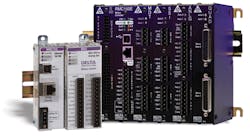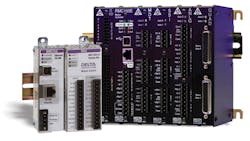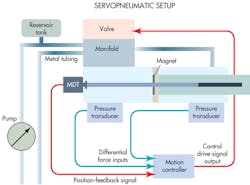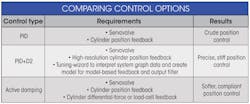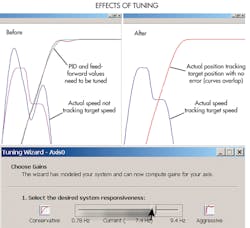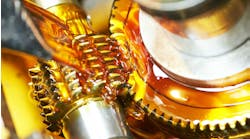Electronic Controls Deliver Precise Pneumatic Motion
When compared to other motion-control methods, there are many reasons to consider powering machines with pneumatics. Unlike electromechanical systems, where the electric power source is typically located right at the actuator, air compressors for pneumatic systems can be located some distance from the cylinder. This means the air cylinder can often be much smaller and lighter compared to a mechanical actuator like a ball screw and its electric motor.
Further, air’s compressibility offers advantages in applications that can benefit from some “give” in the motion. This makes pneumatics attractive, for instance, in packaging systems where care must be taken to avoid damaging fragile products.
Also, because wear in fluid-power systems is less likely to directly affect the accuracy of the motion, servopneumatic systems often require less maintenance when compared to electromechanical systems. This reduces downtime and increases machine productivity.
Another advantage of pneumatics is that fluid-power sources (compressors and pumps) often need only be sized for the average load, whereas electric motors must be sized for the maximum load that will be applied to the system. In low-duty-cycle pneumatic applications, such as systems that move slowly or sporadically, an air tank can store energy and efficiently provide high peak power while using a small compressor. Also, one compressor can serve multiple actuators, which is generally not possible with motor-driven axes. These advantages make pneumatics attractive for many robotic and material-handling applications.
In addition, fluid-power actuators can apply constant pressure to a load without consuming a significant amount of energy. By comparison, applying constant force or holding pressure with electric motors would typically require complex gearing or braking mechanisms to prevent excessive power consumption and overheating.
And compared to hydraulics, pneumatics is clean and, thus, preferable for use in food-handling systems where oil contamination must be avoided.
That said, however, pneumatic power has had some inherent drawbacks compared to other power sources. The compressibility of air, though an advantage in some applications, makes pneumatic motion more difficult to precisely control than “stiff” mechanical-motion systems. And a typical pneumatic valve supports only two positions during operation: fully open and fully closed. This coarse control is acceptable for some motion systems, but other applications need to move with more finesse.
High-performance pneumatics
With effective design, servopneumatic systems can generate smoother and more precise motion than is possible with standard pneumatics, often on par with electromechanical systems.
The key is to use a motion controller with capabilities specifically designed for pneumatic control, and to pair it with other high-performance components. These include:
- Low-static friction cylinders. When selecting cylinders for high-performance applications, it is also important to make the ratio of piston surface area to cylinder air volume as high as possible.
- Servo-quality proportional valves. Such valves can precisely control the pressure on each side of a cylinder and should be used in place of pressure-relief valves or two-position “bang-bang” valves. Fluid-power-enabled motion controllers are capable of directly driving servovalves.
- Feedback sensors. Magnetostrictive displacement transducers (MDT) are often used to provide position information to the motion controller. Pressure transducers mounted in the cylinder on each side of the piston allow the controller to calculate pressure differential and, thus, the force that the pneumatic actuator exerts.
The “servopneumatic setup” graphic shows typical connections between the motion controller and the cylinder, valve, and transducers.
High-performance motion controllers can simultaneously control several motion axes, moving independently or in relation to one another. Some can even select, on the fly, between multiple feedback devices to extend their range of operation (if the feedback devices have different ranges of sensitivity), or protect against the adverse effects of feedback device failure (if redundant feedback devices are used). Delta Computer Systems’ RMC family of motion controllers, for example, can tightly coordinate up to eight motion axes simultaneously and handle a wide range of feedback options, including mathematically calculated feedback values.
Advanced control concepts
The physical differences in pneumatics versus hydraulic and electromechanical systems place different demands on the controller. If the electropneumatic motion controller used for a specific application is only capable of closing the loop with a simple PID algorithm, then the response or bandwidth of the system will be limited by the system hardware’s damping factor and natural frequency. Because pneumatic systems can be particularly “springy” compared to mechanical or hydraulic systems, a regular PID control loop that depends on position feedback alone may not be able to keep up with the reaction of a pneumatic system to stimuli like changes in load or speed. Overshoot of a target position or even oscillations can result.
To combat these effects, controllers use advanced control techniques such as active damping that consider accelerations or forces acting on the system. This sometimes requires adding secondary transducers, depending on the type of active damping, in addition to the primary position feedback. Active damping dramatically reduces oscillations in industrial applications and provides the controlled, compliant motion necessary for high-performance pneumatic machines.
In other cases, the motion controller can use model-based control to provide mathematically enhanced “feedback” for a PID + double-derivative gain (D2) control loop. Higher derivative gains sometimes require an output filter to minimize high-frequency noise in the drive output. Predictive feed-forward gains are not always effective in a pneumatic system, and tuning a servopneumatic system can be challenging. But such advanced control and tuning methods should be used to damp out unwanted motion effects before they arise.
Active damping and PID + D2 with model-based feedback are two strategies that can be applied if the motion controller is capable of processing advanced mathematical functions in closed-loop control. But determining parameter and gain values for control loops incorporating multiple settings can be complex. A solution is to use a motion controller that incorporates automated tuning tools.
Tools simplify design
Such tools build a mathematical model of how the system responds to a stimulus and calculate optimal control-loop parameter gains that produce the best response. An example of such an automated tool is Delta Computer Systems’ Tuning Wizard. Another useful tool for system optimization is Delta’s Plot Manager, which graphically displays how a system’s actual motion compares with target motion profiles. When a system is tuned correctly, the actual motion profile precisely matches the target.
Another issue to consider when selecting control-system components is ease of networking. Modern machines pass control instructions and process data via industry standard networks such as ProfiNet or EtherNet/IP. Electropneumatic motion controllers with standard communication interfaces are easy to incorporate into machines by designers who want to use best-in-class components.
More precise control over the pneumatics can increase machine productivity and, by enabling smoother motion, cut maintenance costs. Of course, pneumatic systems are not the only designs that can benefit from advanced controls. Hydraulic systems can also take advantage of recent developments in control algorithms and tuning tools. With these innovations, the time it takes to tune a system can routinely be reduced by an order of magnitude or more, compared to manual “trial-and-error” methods. And even better, the end product operates with precision that is often attributed to mechanical motion alone.
FOR MORE information on Delta Computer Systems and advanced motion control, visit www.deltamotion.com.
